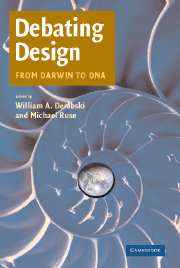Book contents
- Frontmatter
- Contents
- Notes on Contributors
- Debating Design
- INTRODUCTION
- PART I DARWINISM
- PART II COMPLEX SELF-ORGANIZATION
- 8 Prolegomenon to a General Biology
- 9 Darwinism, Design, and Complex Systems Dynamics
- 10 Emergent Complexity, Teleology, and the Arrow of Time
- 11 The Emergence of Biological Value
- PART III THEISTIC EVOLUTION
- PART IV INTELLIGENT DESIGN
- Index
8 - Prolegomenon to a General Biology
Published online by Cambridge University Press: 05 June 2012
- Frontmatter
- Contents
- Notes on Contributors
- Debating Design
- INTRODUCTION
- PART I DARWINISM
- PART II COMPLEX SELF-ORGANIZATION
- 8 Prolegomenon to a General Biology
- 9 Darwinism, Design, and Complex Systems Dynamics
- 10 Emergent Complexity, Teleology, and the Arrow of Time
- 11 The Emergence of Biological Value
- PART III THEISTIC EVOLUTION
- PART IV INTELLIGENT DESIGN
- Index
Summary
Lecturing in Dublin, one of the twentieth century's most famous physicists set the stage of contemporary biology during the war-heavy year of 1944. Given Erwin Schrödinger's towering reputation as the discoverer of the Schrödinger equation, the fundamental formulation of quantum mechanics, his public lectures and subsequent book were bound to draw high attention. But no one, not even Schrödinger himself, was likely to have foreseen the consequences. Schrödinger's What Is Life? is credited with inspiring a generation of physicists and biologists to seek the fundamental character of living systems. Schrödinger brought quantum mechanics, chemistry, and the still poorly formulated concept of “information” into biology. He is the progenitor of our understanding of DNA and the genetic code. Yet as brilliant as was Schrödinger's insight, I believe he missed the center. Investigations seeks that center and finds, in fact, a mystery.
In my previous two books, I laid out some of the growing reasons to think that evolution was even richer than Darwin supposed. Modern evolutionary theory, based on Darwin's concept of descent with heritable variations that are sifted by natural selection to retain the adaptive changes, has come to view selection as the sole source of order in biological organisms. But the snowflake's delicate sixfold symmetry tells us that order can arise without the benefit of natural selection. Origins of Order and At Home in the Universe give good grounds to think that much of the order in organisms, from the origin of life itself to the stunning order in the development of a newborn child from a fertilized egg, does not reflect selection alone.
- Type
- Chapter
- Information
- Debating DesignFrom Darwin to DNA, pp. 151 - 172Publisher: Cambridge University PressPrint publication year: 2004
- 1
- Cited by



